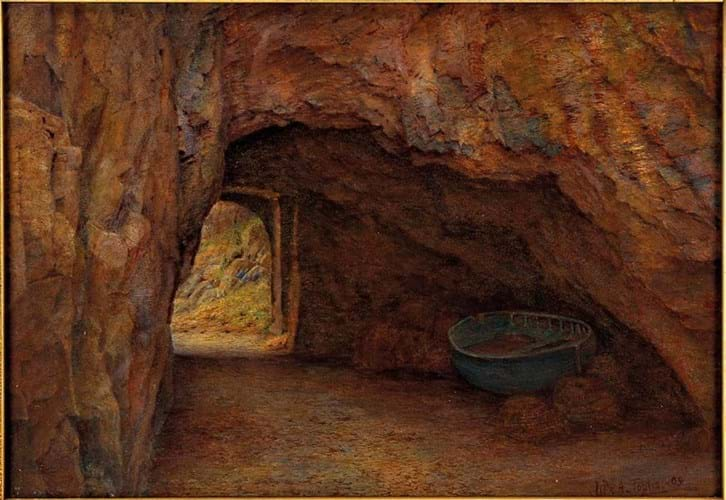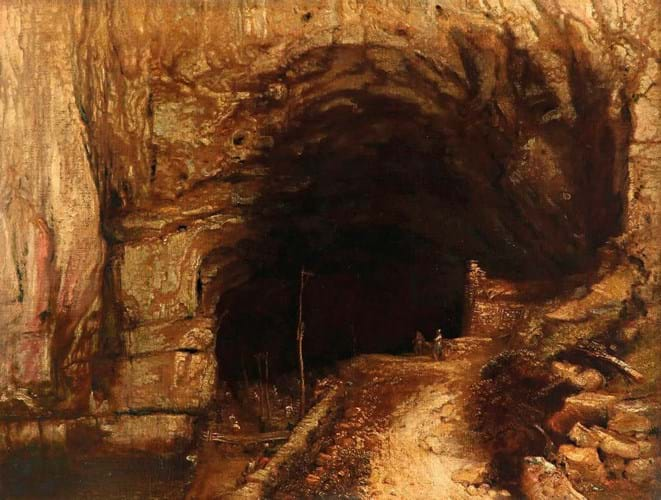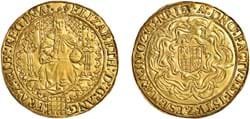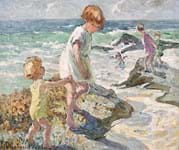While cave painting is a perennial subject of fascination, paintings of caves can also pique the interest of people with an interest in history, as shown by a couple of works that sparked competition at auction recently.
A painting of a cave on the Channel island of Sark appeared at Burstow & Hewett (20% buyer’s premium) in Battle, East Sussex on October 21.
The 9¾ x 14¼in (25 x 36cm) signed watercolour from 1909 was by William Arthur Toplis (1857-1942), a painter unfamiliar to many but one regarded as simply ‘the artist of Sark’ by followers.
Toplis was born in Sheffield and taught himself to paint in early life before attending the Sheffield School of Art while still a teenager. He started exhibiting at the Royal Academy from 1880 onwards and moved to Jersey a year later.
After visiting Sark for a holiday in 1883, he decided to remain there, living on the island until his death in 1942 during the German occupation.
Pictures of the coast and caves of Sark were his speciality. Although he had around 15 paintings of the island accepted for display at the RA, they now appear on the market only very occasionally as most are in private collections or the Guernsey Museum and Art Gallery.
When they do emerge, however, they tend to generate interest from the small number of buyers either from or with a connection to Sark (the island’s population is just 500). Works tend to be ranked on refreshingly artistic grounds – how they capture the beauty and colour of the little island.
The highest price recorded at auction is £6500 for Creux Harbour, Sark that sold at Christie’s in November 2010.
The example in Battle was the first opportunity to buy a work by Toplis at auction for over two years and, as well as its comparative rarity, it had a number of other factors in its favour: the ambient colouring, the finely handled details to the rock, the presence of the boat and the good condition of work (it suffered only from some slight paper discolouration).
It drew significant interest against a £300-400 estimate and was knocked down at £4200 to a buyer on thesaleroom.com; one of the highest prices for a watercolour by the artist and showing that interest remains strong in Channel Islands favourites.
Peak performer
Meanwhile, an earlier picture depicting the largest cave entrance in Britain appeared at Woolley & Wallis (25% buyer’s premium) back on August 11-12.
The painting by James Ward (1769-1859) came as part of a 96-lot consignment from retired dealer Bill Thomson who ran the Albany Gallery in London’s St James’s from 1965 until 2015.
Depicting the opening of Peak Cavern in Castleton, Derbyshire, it was an unusual subject for the artist who was predominantly an animal painter. A few works with similar subjects are known, however, such as a striking painting Ward made of Gordale Scar, a gorge in the Yorkshire Dales, which is now in the Tate.
The 2ft 3in x 2ft 11in (68 x 89cm) signed oil on canvas here was dated 1835 and represented a rare opportunity to acquire such a work and the provenance to Thomson, well known for his expertise in 19th century British paintings, lent it further appeal.
Commanding significant attention against a £1500-2500 estimate at the Salisbury auction, it sold to a UK collector at £11,000.
Overall the Thomson collection made a hammer total of £50,000 hammer, exceeding its top estimate of £48,020, with a selling rate of 72%.
Also attracting interest against an appealing pitch, a portrait of a lady by Irish painter Charles Jervas (c.1675-1739) came as part of a collection of works from The Cider House Galleries in Bletchingley.
The director of the firm, Tony Roberts, died last year and, with the gallery now closed, Woolley & Wallis was asked to sell some of the remaining paintings.
The three-quarter-length depiction of the young subject holding a straw hat and shepherd’s staff was a 4ft 2in x 3ft 5in (1.28 x 1.03m) oil on canvas. It had provenance that traced back to William 5th Lord Digby (1661-1752) and the sitter was believed to be a member of the Digby family.
Although the picture had failed to sell against an estimate of £8000-12,000 at Bonhams in July 2002, it had since been cleaned and here it was offered at a more enticing £800-1200 level. Being ready to hang, it sold to a UK collector at £8000.

















